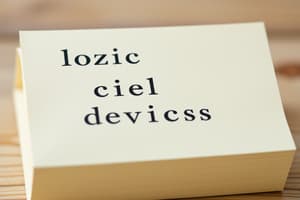Podcast
Questions and Answers
What is the purpose of cohesive devices in writing?
What is the purpose of cohesive devices in writing?
Cohesive devices are words or phrases that help link ideas, sentences, paragraphs or sections of a text. They show the relationship between markers or transitional words.
What cohesive device is used in this sentence: "I was late to work because of the heavy traffic."
What cohesive device is used in this sentence: "I was late to work because of the heavy traffic."
- Correlative conjunctions
- Coordinating conjunctions
- Subordinating conjunctions (correct)
______________ conjunctions are used to link words, phrases, and clauses of equal grammatical rank in a sentence.
______________ conjunctions are used to link words, phrases, and clauses of equal grammatical rank in a sentence.
Coordinating
Which of the following is an example of a correlating conjunction? (Select all that apply)
Which of the following is an example of a correlating conjunction? (Select all that apply)
What is the difference between coordinating and subordinating conjunctions?
What is the difference between coordinating and subordinating conjunctions?
Which of the following are examples of subordinating conjunctions? (Select all that apply)
Which of the following are examples of subordinating conjunctions? (Select all that apply)
Subordinating conjunctions can only join a dependent clause to an independent clause.
Subordinating conjunctions can only join a dependent clause to an independent clause.
Match the type of cohesive device with its purpose:
Match the type of cohesive device with its purpose:
Why are cohesive devices important in academic writing?
Why are cohesive devices important in academic writing?
Flashcards
Cohesive Devices
Cohesive Devices
Words or phrases that link ideas in a text.
Linking Words
Linking Words
Another name for cohesive devices, used for connections.
Cause-and-Effect Relationship
Cause-and-Effect Relationship
Connection showing how one event influences another.
Opposite
Opposite
Signup and view all the flashcards
Sequence
Sequence
Signup and view all the flashcards
Coordinating Conjunctions
Coordinating Conjunctions
Signup and view all the flashcards
Correlative Conjunctions
Correlative Conjunctions
Signup and view all the flashcards
Subordinating Conjunctions
Subordinating Conjunctions
Signup and view all the flashcards
Addition Connectives
Addition Connectives
Signup and view all the flashcards
Comparison Connectives
Comparison Connectives
Signup and view all the flashcards
Contrast Connectives
Contrast Connectives
Signup and view all the flashcards
Order/Sequence Connectives
Order/Sequence Connectives
Signup and view all the flashcards
Time Connectives
Time Connectives
Signup and view all the flashcards
Reason Connectives
Reason Connectives
Signup and view all the flashcards
Enumeration Connectives
Enumeration Connectives
Signup and view all the flashcards
Result Connectives
Result Connectives
Signup and view all the flashcards
Example Connectives
Example Connectives
Signup and view all the flashcards
Summarize Connectives
Summarize Connectives
Signup and view all the flashcards
FANBOYS
FANBOYS
Signup and view all the flashcards
Linking Phrase
Linking Phrase
Signup and view all the flashcards
Contradictory Cues
Contradictory Cues
Signup and view all the flashcards
Transition Words
Transition Words
Signup and view all the flashcards
Flow of Ideas
Flow of Ideas
Signup and view all the flashcards
Text Cohesion
Text Cohesion
Signup and view all the flashcards
Independent Clause
Independent Clause
Signup and view all the flashcards
Dependent Clause
Dependent Clause
Signup and view all the flashcards
Overall Structure
Overall Structure
Signup and view all the flashcards
Reinforcement of Ideas
Reinforcement of Ideas
Signup and view all the flashcards
Analytical Connectives
Analytical Connectives
Signup and view all the flashcards
Conclusion Connectives
Conclusion Connectives
Signup and view all the flashcards
Study Notes
Cohesive Devices
- Cohesive devices (linking words, discourse markers, transitional words) show relationships between ideas, sentences, paragraphs, and text sections.
- Examples of cohesive devices are used to illustrate how they indicate relationships.
Coordinating Conjunctions
- Coordinating conjunctions join words, phrases, and clauses of equal grammatical rank.
- The most common coordinating conjunctions are FANBOYS (for, and, nor, but, or, yet, so).
- Examples are provided to illustrate how they are used.
Correlative Conjunctions
- Correlative conjunctions are pairs of conjunctions that work together.
- Examples include either/or, neither/nor, and not only/but also.
- Examples show their use in sentences.
Subordinating Conjunctions
- Subordinating conjunctions join independent and dependent clauses.
- They can signal cause-and-effect, contrast, or other relationships between clauses.
- Common examples include because, since, as, although, though, while, and whereas.
- Adverbs like until, after, and before can also function as subordinating conjunctions.
- Examples illustrate how these conjunctions are used.
Commonly Used Connectives
- A list of commonly used connectives and when to use them is provided.
- These connectives fall into categories like adding ideas, comparison, contrast, order/sequence, time, reason, enumeration, result, example, and summarization.
- Specific examples of connectives for each category are given.
Studying That Suits You
Use AI to generate personalized quizzes and flashcards to suit your learning preferences.




